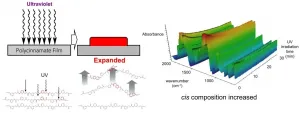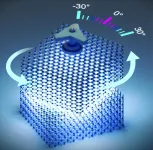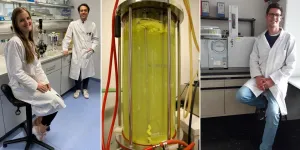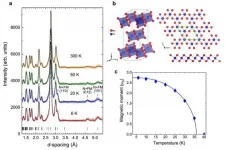(Press-News.org) A phenomenon of "photoexpansion" in hard plastic films with a high glass transition temperature in the dry state was established, which was essentially different from very soft actuators, such as elastomers or gels. The photoexpanding hard actuators were expected to apply in the wide fields because they do not contain vaporable matters such as solvents and were much more thermoresistant than conventional ones.
Ishikawa, April 22, 2021 - Polymers that exhibit their functions by light have been studied for a few decades because they enable device miniaturization, energy saving, and precise signal control. Polymers based on azobenzene, diarylethene, etc. are the pioneers, and many examples of light-driven motors and artificial muscles have been reported. On the other hand, cinnamic acid, which is a constituent of lignin in natural wood, also exhibit the function by ultraviolet (UV) rays, so that it has been applied to polymers. The deformation mechanism of these cinnamate-based polymers has not been clarified because the two reactions of double bond cis-trans isomerization and [2+2] cycloaddition occur almost simultaneously. Since the mechanism has not been clarified, its use as a photodeformable material has not received as much attention as the above-mentioned azobenzene and diarylethene.
To tackle these issues, a team of researchers from Japan Advanced Institute of Science and Technology (JAIST) are investigating photobending mechanism of bio-based polycinnamete films. Their latest study, published in ACS Applied Materials & Interfaces, was led by Professor Tatsuo Kaneko and Assistant Professor Kenji Takada also involved Professor Hideyuki Murata, Associate Professor Kosuke Okeyoshi, and Research Assistant Professor Amit Kumar.
In this study, polyesters were synthesized based on coumarates in which hydroxyl groups were substituted in the aromatics of cinnamate. Among them, those showing photodeformability were poly(3-hydroxycinnamic acid) (P3HCA) and poly(3,4-dihydroxycinnamic acid) (PdHCA). Although both films had a cinnamate unit, P3HCA showed convex deformation with respect to an UV source, and PdHCA showed concave deformation, respectively. These differences were analyzed by various spectral analyzes. First, when the fluorescence lifetime was measured, it was found that there are two excited states in P3HCA. Next, by time-resolved infrared (IR) spectroscopic measurement, the absorption of the double bond of the cinnamate unit was traced from the change in the IR spectrum during UV irradiation. In case of P3HCA, it was confirmed that the absorption of cis-formed -CH=CH- bond was increased by increasing the UV irradiation time. On the other hand, in PdHCA, no change in the absorption of cis-formed -CH=CH- was confirmed. To prove these photoexpansions, an experiment was conducted in which a P3HCA film was covered with a photomask and UV rays were irradiated from above. When the free-standing film was irradiated with UV through a photomask, the non-irradiated surface also showed a deformation. Therefore, when an irradiation experiment was conducted with the P3HCA film coated on the glass substrate, there was no deformation of the surface, opposite side, not irradiated with UV, and no deformation of the part covered with the photomask was observed. From the above results, it was found that P3HCA exhibits convex deformation by "expanding" with respect to UV owing to cis isomerization.
There is no other example that is bio-based and can control the deformation with respect to UV light. In addition, by elucidating the deformation mechanism of polycinnamates through this research, precise control of photodeformability based on a dense polymer design can be expected. The fact that the photodeformability differs depending on the "shape" of the molecule, as Prof. Kaneko explains: "even though they are the same constituents, deformation behaviors were different. These results strongly support the correlation between the structure and physical properties of the cinnamate-based polymers, and this study become the good perspective of the bio-based and photoresponsive polymers." In addition, they consider, it can be expected to greatly contribute to the development of new materials based on the molecular design.
Further progress in bio-based polycinnamate as photodeformable materials will hopefully get us closer to more precisely controllable actuator and a sustainable society.
INFORMATION:
Reference
Title of original paper: "Photoexpansion of Biobased Polyesters: Mechanism Analysis by Time-Resolved Measurements of an Amorphous Polycinnamate Hard Film"
Journal: ACS Applied Materials & Interfaces (ACS Publications)
DOI: 10.1021/acsami.0c22922
About Japan Advanced Institute of Science and Technology, Japan
Founded in 1990 in Ishikawa prefecture, the Japan Advanced Institute of Science and Technology (JAIST) was the first independent national graduate school in Japan. Now, after 30 years of steady progress, JAIST has become one of Japan's top-ranking universities. JAIST counts with multiple satellite campuses and strives to foster capable leaders with a state-of-the-art education system where diversity is key; about 40% of its alumni are international students. The university has a unique style of graduate education based on a carefully designed coursework-oriented curriculum to ensure that its students have a solid foundation on which to carry out cutting-edge research. JAIST also works closely both with local and overseas communities by promoting industry-academia collaborative research.
About Professor Tatsuo Kaneko and Assistant Professor Kenji Takada from Japan Advanced Institute of Science and Technology, Japan
Tatsuo Kaneko received a B.S. in Tokyo Tech in 1993, and a Ph.D. in Polymer Chemistry from the same university in 1998. One year before received Ph.D., he joined the faculty as an Assis Prof at Hokkaido Univ, and then moved to Kagoshima Univ and Osaka Univ. After that, he joined JAIST and promoted to Full Professor in 2016. He also joined UCLA as a Visiting Assoc Prof under the acceptance of Prof. Timothy Deming in 2012. Current research interests include soft matters, polyelectrolytes, and bioplastics, for which he has received awards from Chemical Society of Japan and from several foundations. International prizes such as "Best presentation" at the 251st ACS National Meeting, "Distinguished Award" at the 12th IUPAC NMS-XII, and "Gottfried Wagener prize" The 9th German Innovation Award have also been given.
Kenji Takada received his B.S in Hokkaido University in 2011, and a Ph.D. in Polymer Chemistry from the same university in 2015. He was subsequently appointed as a researcher and post doctor as JSPS research fellow for young scientists DC1 and PD. In 2021, he joined to JAIST as an Assistant Professor. His research interests are living anionic or radical polymerization of vinyl monomers. He is also studying about biomolecules-based plastics, high-performance polymers, and photo-functionalized materials.
Funding information
This study was supported by the JST-ALCA Program (grant umber JPMJAL1010).
Patients with chronic kidney dysfunction frequently develop thickening of the heart muscle, so-called left ventricular hypertrophy. This is particularly pronounced in patients who are in the late stage of renal dysfunction, that is to say those requiring renal replacement therapy such as haemodialysis. The danger of this cardiac hypertrophy lies in the considerable associated increase in risk of acute cardiovascular disease, such as sudden cardiac death, for example. Haemodialysis patients have a number of risk factors for developing this form of cardiac hypertrophy. One of those is elevated levels of the protein Fibroblast Growth Factor 23 (FGF23), ...
- Recent discoveries focused on manipulation of atomically-thin 2D materials, while the new breakthrough can be used to stack technologically-relevant 3D materials at a twist angle
- Method allows continuous, systematic control of optical emission intensity and energy, and can produce ultraviolet emissions at room temperature for bulk systems
- The discovery can be significant for applications in medicine, environmental or information technologies.
Singapore, 22 April 2021 - Researchers from the Low Energy Electronic Systems (LEES) Interdisciplinary Research ...
The citric acid cycle is an important metabolic pathway that enables living organisms to generate energy by degrading organic compounds into carbon dioxide (CO?). The first step in the cycle is usually performed by the enzyme citrate synthase, which builds citrate. But, in the absence of oxygen (under anaerobic conditions), some bacteria can perform the reverse cycle: They can build up biomass from CO?. In this so-called reversed citric acid cycle, citrate synthase is replaced by ATP-citrate lyase, which consumes cells' universal energy carrier ATP (adenosine triphosphate) to cleave citrate instead of forming it. However, a few years ago, a research team led by Ivan Berg (University of Münster) and Wolfgang Eisenreich (Technical University of Munich) discovered that instead of ...
A new study from the University of Surrey has found that among people aged 55 to 75 more frequent use of the internet was beneficial for mental health and quality of life under lockdown. Those who used the internet more, particularly for staying in touch with friends and family, were at lower risk of depression and reported a higher quality of life.
Loneliness and social isolation have been major problems for many under lockdown, and for older people in particular. Loneliness raises risk of depression and other negative health outcomes. In a paper published in the journal Healthcare, researchers from Surrey investigated ...
Australia's unique and highly endemic flora and fauna are threatened by rapid losses in biodiversity and ecosystem health, caused by human influence and environmental challenges. To monitor and respond to these trends, scientists and policy-makers need reliable data.
Biodiversity researchers and managers often don't have the necessary information, or access to it, to tackle some of the greatest environmental challenges facing society, such as biodiversity loss or climate change. Data can be a powerful tool for the development of science and decision-making, which is where the END ...
Rain is a common phenomenon on Earth. There is a similar phenomenon on the Sun, called coronal rain. It is related to the coronal heating and magnetic field, and plays a fundamental role in the mass cycle between the hot, tenuous corona and the cool, dense chromosphere.
Coronal rain usually takes place in post-flare loops and the non-flaring active region coronal loops. It is generally classified into two categories: flare-driven and quiescent coronal rain, depending on its relation to the flare. Both kinds of coronal rain form along structures that are magnetically ...
Understanding whether Mars was once able to support life has been a major driving force for Mars research over the past 50 years. To decipher the planet's ancient climate and habitability, researchers look to the rock record - a physical record of ancient surface processes which reflect the environment and the prevailing climate at the time the rocks were deposited.
In a new paper published in JGR: Planets, researchers on the NASA-JPL Mars Science Laboratory mission used the Curiosity rover to add another piece to the puzzle of Mars' ancient past by investigating a unit of rocks within Gale crater.
They found evidence of an ancient dune field preserved as a layer of rocks in Gale crater, which overlies rock layers that were deposited in a large lake. The rock ...
Thursday, 22 April 2021 - New research has found that childhood adversity, such as parental conflict, death of a close family member or serious injury, before the age of nine was associated with mental health problems in late adolescence.
However, the research also shows that improving the relationship between parents and children could prevent subsequent mental health problems, even in children who have experienced severe adversities. The research also indicated that improving a child's self-esteem and increasing their levels of physical activity can help to reduce the risk of developing mental health problems.
The study, led by researchers from RCSI University of Medicine and Health Sciences, is recently published in END ...
NUST MISIS scientists together with Indian colleagues from Jain University and Sri Dharmasthala Manjunatheshwara College presented innovative membranes for the complete removal of heavy metals from industrial wastewater. The special nanostructure of zinc-modified aluminum oxide made it possible to remove arsenic and lead from water with an efficiency of 87% and 98%, respectively. The results of the work were published in the Chemosphere journal.
Industrialization is the main cause of water pollution due to the ingress of industrial waste. In particular, heavy metals -- arsenic, lead and cadmium -- can cause metabolic disorders and multiple critical effects to the body, ...
Two-dimensional (2D) materials with a single-layer thickness retaining magnetic order in atomically thin limit began to increase their scientific and technological significance after the successful synthesis of graphene and later investigations of van der Waals materials. CrBr3 has been known since the 60s as a van der Waals ferromagnet. Hansen, Tsubokawa, and Dillon have pioneered the work on magnetism in this compound. However, it has only recently been established that CrBr3 exhibits ferromagnetism when exfoliating to several layers and monolayers while ...





